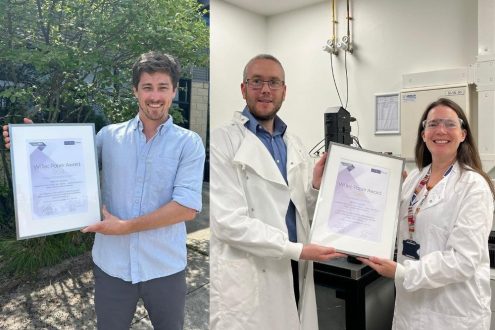BASF presents new research findings and novelties in applied methods technologies at IFSCC Congress
- From September 19-22, BASF and its research partners share scientific findings relevant to the personal care industry
- Poster and podium sessions cover a wide range of topics, from innovative research models and methods to new cosmetic ingredients
- The 32nd IFSCC Congress is hosted by the Society of Cosmetic Scientists in London
At this year’s International Federation of Societies of Cosmetic Chemists (IFSCC) Congress, BASF scientists will present new findings and novelties in research methods for the development of effective cosmetics. Outstanding research results include the discovery of the age-dependent decrease of skin-native bacteria and the development of a cosmetic ingredient filling up this abundance gap with live microorganisms. Further research projects cover a first-time applied novel neuroskin-on-chip method designed by NETRI to create a 3D innervated skin model, and a joint study with the Stanford University on emollients that can reduce skin drying stresses and promote skin well-being. BASF scientists and experts will discuss impact and opportunities ahead in podium sessions as well as poster exhibitions.
New method reveals specificities of sensitive skin
Although the skin microbiome is considered important in skin health, the relationship between the skin microbiome and skin sensitivity has received little attention so far. In a recent study, BASF scientists examined the composition of the skin microbiota of individuals with sensitive compared to non-sensitive skin. The analysis revealed changes in presence and abundance of common and specific bacteria strains. For the first time, a droplet-based microfluidic technology (DBMT) developed by Biomillenia was used to isolate these bacterial strains in culture. The microbial library thus obtained can be used to identify and test active ingredients with the best potential to restore the balance of the microbiota of sensitive skin.
Neuroskin-on-chip technology mimics innervated skin
For healthy skin, the supply network of nerve cells is an essential factor. To develop and test neurocosmetics that help to improve the interactions between the skin and the nervous system and thus contribute to reducing signs of aging or skin stress, accurate skin models are needed. Together with NETRI, a French start-up and expert in rapid prototyping of organs-on-chip, BASF succeeded for the first time in growing an innervated epidermis on a chip. Compared to existing innervated epidermis or skin models made by classical coculture, the novel neuroskin-on-chip technology better mimics the real innervation physiology of skin. It thus facilitates and improves the testing of high-performance neurocosmetic active ingredients.
Selection of emollients supports skin hydration
How people rate the efficacy of skin care products is highly dependent on skin hydration and skin biomechanics. Therefore, a key metric to optimize performance is to better understand the effects of biomechanical stress developed in the stratum corneum during desiccation. To investigate the influence of cosmetic ingredients’ drying stresses, a team of researchers from BASF and the lab of Prof. Reinhold Dauskardt at Stanford University examined skin care formulations that included different emollients with widely varying properties and molecular structures. The results indicate that by careful selection of emollients and other ingredients, skin drying stresses can be reduced, and skin-wellbeing promoted.
Probiotic anti-aging ingredient with live bacteria
Skin aging remains one of the most important fields in cosmetics. To better understand the relationship between aging and changes in the skin microbiome, BASF researchers conducted a study with younger and older cohorts. It revealed significant differences in the populations of Lactobacillus strains. L. crispatus in particular could be identified as a “youth bacterium”: it was abundant in younger skin, but not detectable in the hollow wrinkle of the older cohort. These results paved the way for the development of a probiotic for applications for healthful aging. The research team succeeded in developing a product that ensured the survival of the bacteria when included in suitable cosmetic formulations. This makes the ingredient the first to be based on skin-native and live bacteria. Its anti-aging efficacy has been demonstrated in vitro and in vivo versus placebo.
Strategy to combat age-related changes of scalp and hair based on plant extracts
With increasing age, the structure of the scalp and its ability to regenerate change. As a result, hair loss may occur, negatively affecting self-confidence and well-being. BASF scientists developed a holistic anti-aging approach for scalp and hair follicles based on a temperance strategy with three main objectives: moderation of scalp sensitivity by protecting the epidermal barrier, balancing the microbiota, and moderating the excessive immune response. For this purpose, plant extracts were selected for their TRPV1-antagonist properties and the best extract was studied for its effects on the above-mentioned parameters. In this way, a plant extract could be identified that is suitable to help counteract age-related changes of scalp and hair.
Interactive matrix for skin care products targeting (anti-)pollution
Pollutants are varied in terms of both nature and the effects they can have on the skin. Cosmetic skin care products need to be formulated and claims substantiated accordingly. The Anti-Pollution working group of the German Society for Scientific and Applied Cosmetics (DGK) developed a publicly accessible, interactive matrix containing information on air pollutants, some of their effects on the skin, cosmetic ingredients and applications, and relevant methods for evaluating efficacy. The matrix is not intended to be complete, but to facilitate a better understanding of factors that may be involved and how to address claim support challenges when developing relevant skin care products.
The BASF division Care Chemicals offers a broad range of ingredients for personal care, home care, industrial & institutional cleaning, and technical applications. We are a leading global supplier for the cosmetics industry as well as the detergents and cleaners industry, and support our customers with innovative and sustainable products, solutions and concepts. The division’s high-performance product portfolio includes surfactants, emulsifiers, polymers, emollients, chelating agents, cosmetic active ingredients and UV filters. We have production and development sites in all regions and are expanding our presence in emerging markets. Further information is available online at www.care-chemicals.basf.com.
About BASF
At BASF, we create chemistry for a sustainable future. We combine economic success with environmental protection and social responsibility. Around 111,000 employees in the BASF Group contribute to the success of our customers in nearly all sectors and almost every country in the world. Our portfolio comprises six segments: Chemicals, Materials, Industrial Solutions, Surface Technologies, Nutrition & Care and Agricultural Solutions. BASF generated sales of €78.6 billion in 2021. BASF shares are traded on the stock exchange in Frankfurt (BAS) and as American Depositary Receipts (BASFY) in the U.S. Further information at www.basf.com.
BASF Personal Care and Nutrition GmbH
Rheinpromenade 1
40789 Monheim am Rhein
Telefon: +49 (2173) 4995-0
Telefax: +49 (2173) 4995-500
http://www.monheim.basf.de
Communications Manager
Telefon: +49 (2173) 4995-446
E-Mail: annika.mueller@basf.com
![]()





